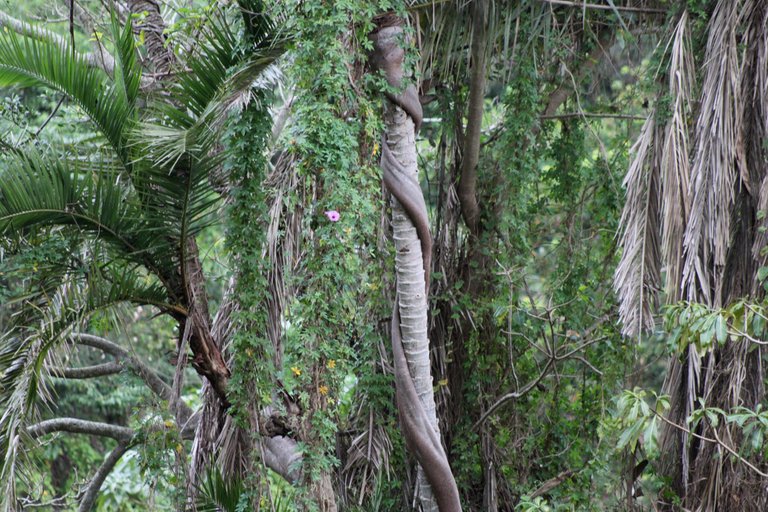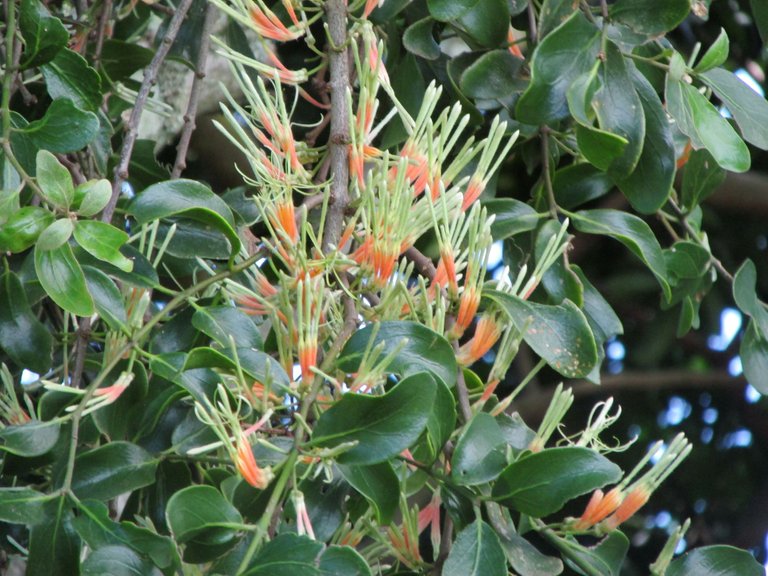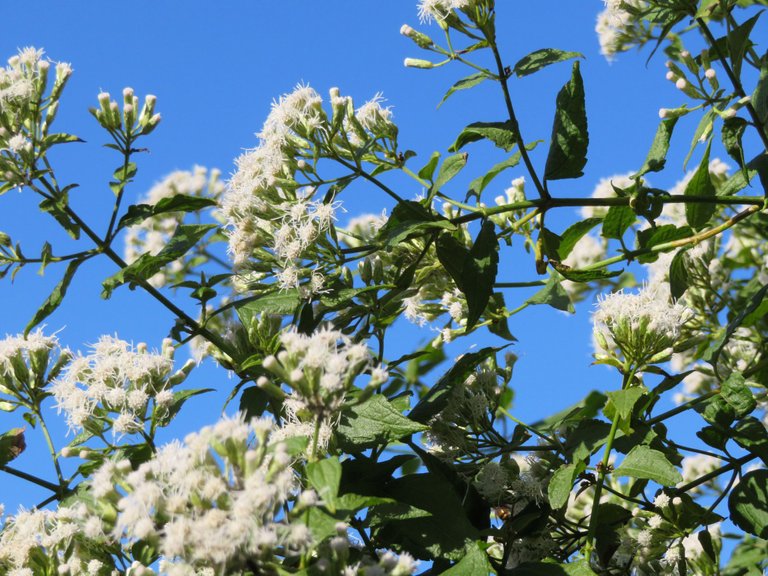Equal Rights For Parasitic Plants
Parasitic Plants
Through life we find parasites in many shapes and forms, yes human too. Weekly Amazing Nature content topic Parasitic Plants hosted by @bucipuci leading the challenge.
Almost good enough to call the Hitchhikers Guide In Plant Life!
Plants that sponge off another, using natural resources offered by host plant, in most cases do not kill their food source and may thrive together sharing a limb of a tree or root for some time. Perhaps evolution is taking life into the plant kingdom a step further by using another tree to start life.
In our region we have a few of these notoriously adaptive plants which we remove from established trees not taking a chance as quite often they do pose a problem to the original tree.
Most dramatic example to show is the Strangler Figs (Ficus natalensis, F. lutea and F. stuhlmannii)
Extremely hostile fig we call the strangler fig starts off in host tree possibly a branch with sufficient nutrients to start. Spread by birds, monkeys depositing seed high up, the fig will send it's rooting down to the ground.
Slowly winding down the tree, strangling original tree which eventually dies off, the strangler fig takes over this patch of sunlight having a good start to life.
Fate is sealed, many years later when the strangler itself dies off the original tree will be evident in the remains, entombed in the tree trunk, stolen nutrients and water started the life of the plant on a branch, then throwing roots down to the soil eventually overcoming the tree while planting itself firmly in the ground.
Different parts of the plant depending on which region are used for a variety of different uses, looking at the strangler fig I would not be able to tell which is which so will not go into detail.
Hairy mistletoe or wood flower (Erianthemum dregei)
On a branch half way up the tree we noticed this flowering, these to my knowledge are not as destructive as the above mentioned giving a pretty flower, total growing size about 1.5m with flowers approximately 15mm in size.
Erianthemum dregei apparently is used in African traditional medicine, treating stomach problems children may have.
Parasitic plants are fascinating in being able to establish a life for themselves, one dwelling on another, each has different reasons for growth like this to get more reasoning into how this works I have placed the link below for those who would enjoy learning more.

All this talk about these invasive plants reminds me I do have a few that need to be removed with birds flying over planting or monkeys moving through there are some I am able to reach to snip off my bushes.
One I do not know that has flowered off of the Natal Plum Bush, unable to reach where it is embedded due to the thorns, so here it grows with no name!

All photography my own using Canon Powershot SX730 HS camera. Any queries or requests please drop a comment below or make contact with me, have a wonderful day! Photography without tripod, go with the flow wherever life takes you. NB: Amateur photographer in nature, keep smiling!
Thought for Today: "All plants are our brothers and sisters and they talk to us and if we listen we can hear them." - African Proverb
Communities to Enjoy On Hive: #lifestylelounge @hive-114105, #qurator @hive-102880, #featheredfriends @hive-106444, #wednesdaywalk @hive-155530, #amazingnature @hive-127788, #alwaysaflower @hive-154065, #feelgood @hive-19093, #theterminal @hive-101265, #ladiesofhive @hive-124452






Hello dear friend @joanstewart good morning
I loved your entry for the contest, a very fun theme for this week.
Chilling the attitude of the strangler fig, is like inviting your neighbor to sleep at home and finally he kicks you out of yours.
I appreciate that you shared all this information, I take this opportunity to wish you a splendid weekend
Strangler fig is a relatively common sight down here I used that photo detailing how it works it's way down the host. Thanks for visiting and enjoying, appreciated @jlufer
!ENGAGE 20
ENGAGEtokens.Fascinating! Great info and photos, thanks for sharing.
Thanks for visiting and enjoying, everything happens in nature!
Thank you for entering the competition.
It is good to learn something about plants from another continent.
B.t.w. @joanstewart. In order to comply with the competition rules, I will ask you to include a link to your article in the comments below the original challenge.
Popped in this morning and placed correctly, thanks @bucipuci end of a day I normally forget 😉
:-)
hello, your post is very educational for me. Keep it going.
I heard about Erianthemum dregei using for medicinal purpose but you have completed my knowledge with the rest!
Like to read your content
Many plants are put to good use, one learns more in different regions from the local communities.
Thanks for visiting and have a great day!
!ENGAGE 20
ENGAGEtokens.Great photos for an amateur photographer. I’m doing my best to produce nice photos but I think I need a good subject and a wonderful place
Some great topics to share into communities, have a wonderful weekend and thanks for visiting @long888
Such beauty in those parasitic plants, yes? We have some too and we don't even have monkeys! When You say that though, that would be a little alarming as they are mostly in the treetops, where I have no chance of getting to. We have mostly vines that become invasive and take over.
But tree? That is fascinating and a little horrifying. :)) Do the figs bear fruit of just an attitude?
This was an awesome post, Joan!!! I loved it! Have a wonderful weekend!
Some are pretty, others manic in attitude!
The strangler fig does provide fruit which the birds love, poo gets transported far and wide....
Never ending cycle of life eat or be eaten, even in the world of plants.
Have an amazing weekend and thanks for visiting Denise.
❤️
Lots of good information Joan. The strangler fig has a fitting name with it’s destructive nature.
One needs a !BEER after seeing how murderous that fig is.:)
They obtain great height in some areas of 20 meters, with huge base, roots do split rocks, not a good idea anywhere close to buildings. Figs are edible but not really tasty as such, a smaller fig the birds love and wasps lay their larvae in.
!LUV
Hi @redheadpei, you were just shared some LUV thanks to @joanstewart. Having at least 5 LUV in your wallet enables you to give up to 3 LUV per day, for free. See the LUV tokens in your wallet at https://hive-engine.com or learn about LUV at https://peakd.com/@luvshares
View or trade
BEER.Hey @joanstewart, here is a little bit of
BEERfrom @redheadpei for you. Enjoy it!Learn how to earn FREE BEER each day by staking your
BEER.Very interesting post. Thanks for teaching us about your area.
So nice to see you @viking-ventures thanks for visiting trust you are all keeping well.
We are doing well enough, thank you.
Good to see you too. I hope all is well.
Good to hear you are all well, have a lovely week @viking-ventures
Congratulations @joanstewart! You have completed the following achievement on the Hive blockchain and have been rewarded with new badge(s) :
Your next target is to reach 24000 replies.
You can view your badges on your board and compare yourself to others in the Ranking
If you no longer want to receive notifications, reply to this comment with the word
STOPCheck out the last post from @hivebuzz:
Support the HiveBuzz project. Vote for our proposal!
Almost too late, but here goes.
We have one of those Hairy Mistletoe trees growing right here in our garden. Still young, so I will most certainly take it out.
Another culprit is the Ivy creeper, as they also cover the trees.
We had to cut our way through strangled forests in the farm ravines when we worked on the Durban to Richards bay high power line towers. Many sugar cane farmers planted in the servitude below the towers and I had to face endless arguments by angry farmers when we cleared the servitudes of their beloved sugar cane plantings. But the cable stringing trucks had to come through and there was no other way. All of the copper cables were removed and replaced with Panther aluminium cables.
But the Freestate farmers were worse as we had to remove their mielie plants on the servitude, but that's another story 🤣
A great post here Lady Joan.
!LUV
!BEER
Hairy Mistletoe may not be too invasive, I looked at this one I photographed the other day and it appears about the same as it did last year.
Ivy I have hacked out, grows everywhere given half a chance in Durban. Sugarcane farmers used to clear and burn below power lines down this side of town, expensive in labour!
!LUV
!ENGAGE 20
The Mistletoe here is a young one and it was planted next to a clump of trees that blocks the hot summer sun from the bedroom window. So I will leave it for now and see how it grows.
Ivy is also things that I don't like and we don't have any here. Although there are other houses here in the complex that has Ivy on their garden walls.
We found isolated farms that kept the servitudes clear under the towers, but other farms gave me a lot of stress. Sugar cane even growing inside the towers.
So they didn't like me very much and they refused to admit that they were wrong.
Blessings,
!LUV
!ENGAGE20
It will get a pretty flower most times too high up to do much about removing them, we get a lot planting onto certain smaller trees I do remove. Ivy is pretty in colder climates when controlled or used for a purpose, not something I would put onto a house, but that is personal taste.
Had black snow falling again last week with coastal sugar being harvested again, what a mess... Well the winds arrived, then thunder and lightning for the last two nights, now some heavy rain this morning will wash it all clean again.
!WINE
!LUV
Hi @papilloncharity, you were just shared some LUV thanks to @joanstewart. Having at least 5 LUV in your wallet enables you to give up to 3 LUV per day, for free. See the LUV tokens in your wallet at https://hive-engine.com or learn about LUV at https://peakd.com/@luvshares
ENGAGEtokens.Hi @joanstewart, you were just shared some LUV thanks to @papilloncharity. Having at least 5 LUV in your wallet enables you to give up to 3 LUV per day, for free. See the LUV tokens in your wallet at https://hive-engine.com or learn about LUV at https://peakd.com/@luvshares
ENGAGEtokens.Hi @papilloncharity, you were just shared some LUV thanks to @joanstewart. Having at least 5 LUV in your wallet enables you to give up to 3 LUV per day, for free. See the LUV tokens in your wallet at https://hive-engine.com or learn about LUV at https://peakd.com/@luvshares
Hi @joanstewart, you were just shared some LUV thanks to @papilloncharity. Having at least 5 LUV in your wallet enables you to give up to 3 LUV per day, for free. See the LUV tokens in your wallet at https://hive-engine.com or learn about LUV at https://peakd.com/@luvshares
View or trade
BEER.Hey @joanstewart, here is a little bit of
BEERfrom @papilloncharity for you. Enjoy it!Learn how to earn FREE BEER each day by staking your
BEER.